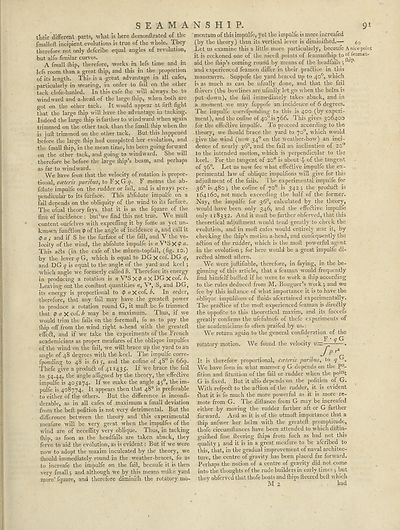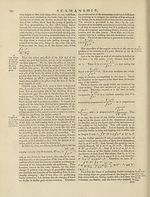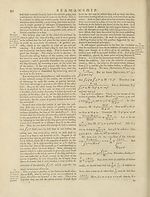Encyclopaedia Britannica, or, a Dictionary of arts, sciences, and miscellaneous literature : enlarged and improved. Illustrated with nearly six hundred engravings > Volume 19, Scripture-SUG
(99) Page 91
Download files
Complete book:
Individual page:
Thumbnail gallery: Grid view | List view

9i
SEAMANSHIP.
tlieir different parts, what is here demonftrated of^ the
fmalleft incipient evolutions is true of the whole. They
therefore not only defcribe equal angles of revolution,
but alfo fimilar curves.
A fmall (hip, therefore, works in lefs time and in
lefs room than a great (hip, and this in the proportion
of its length. This is a great advantage in all cafes,
particularly in wearing, in order to fail on the other
tack clofe-hauled. In this cafe (lie will always be to
windward and a-head of the large fhip, when both are
got on the other tack. It would appear at firft fight
that the large (hip will have the advantage in tacking.
Indeed the large (hip is farther to windward when again
trimmed on the other tack than the fmall {hip when {lie
is juft trimmed on the other tack. But this happened
before the large {hip had completed her evolution, and
the fmall {hip, in the mean time, has been going forward
on the other tack, and going to windward. She will
therefore be before the large {hip’s beam, and perhaps
as far to windward.
We have feen that the velocity of rotation is propor¬
tional, cceteris paribus, to F x G y. F means the ab-
folute impulfe on the rudder or fail, and is always per¬
pendicular to its furface. This abfolute impulfe on a
fail depends on the obliquity of the wind to its furface.
The ufual theory fays, that it is as the fquare of the
fine of incidence : buFwe find this not true. We muft
content ourfelves with exprefling it by fome as yet un¬
known fumftion <p of the angle of incidence a, and call it
Q a ; and if S be the furface of the fail, and V the ve¬
locity of the wind, the abfolute impulfe is ?i V’S X <P «-
This afts (in the cafe of the mizen-topfail, (fig. 10.)
by the lever q G, which is equal to DG X Cof. DG y,
and DG y is equal to the angle of the yard and keel ;
which angle we formerly called b. Therefore its energy
in producing a rotation is « V*S X « X FIG X cof.
Leaving out the conftant quantities «, V*, S, and DG,
its energy is proportional to ip « X eof. b. In order,
therefore, that any fail may have the greateft power
to produce a rotation round G, it muft be fo trimmed
that <p « X cof. b may be a maximum. Thus, if we
would trim the fails on the foremaft, fo as to pay the
(hip oft' from the wind right a-head with the greateft
effeft, and if we take the experiments of the French
academicians as proper meafures of the oblique impulfes
of the wind on the fail, we will brace up the yard to an
angle of 48 degrees with the keel. The impulfe corre-
fponding to 48 is 615, and the cofine of 48° is 669.
Thefe give a produft of 411435. If we brace the fail
to 54.44, the angle afligned by the theory, the efteftive
impulfe is 405274. If we make the angle 450, the im¬
pulfe is 408774. It appears then that 48° is preferable
to either of the others. But the difference is inconfi-
derable, as in all cafes of maximum a fmall deviation
from the beft pofition is not very detrimental. But the
difference between the theory and this experimental
meafure will be very great when the impulfes of the
wind are of neceflity very oblique. Thus, in tacking
{hip, as foon as the headfails are taken aback, they
ferve to aid the evolution, as is evident: But if wre were
now to adopt the maxim inculcated by the theory, wre
ftiould immediately round in the weather-braces, fo as
to increafe the impulfe on the fail, becaufe it is then
very fmall 5 and although we by this means make yard
more* fquare, and therefore diminifh the rotatory mo¬
mentum of this impulfe, yet the impulfe is more increafed
(by the theory) than its vertical lever is diminiftied.— <50
Let us examine this a little more particularly, becaufe Anice point
it is reckoned one of the niceft points of feamanfliip to of teaman-
aid the {hip’s coming round by means of the headfails •,
and experienced feamen differ in their pra&ice in this
manoeuvre. Suppofe the yard braced up to 40°, which
is as much as can be ufually done, and that the fail
Ihivers (the bowlines arc ufually let go when the helm is
put down), the fail immediately takes aback, and in
a moment we may fuppofe an incidence of 6 degrees.
The impulfe correfponding to this is 400 (by experi¬
ment), and the cofine of 40° is 766. This gives 306400
for the effective impulfe. To proceed according to the
theory, we ftiould brace the yard to 70°, which would
give the wind (now 340 on the weather-bow) an inci¬
dence of nearly 36°, and the fail an inclination of 20°
to the intended motion, which is perpendicular to the
keel. For the tangent of 20° is about 4 of the tangent
of 36°. Let us now fee what effedtive impulfe the ex¬
perimental law of oblique impulfions will give for this
adjuftment of the fails. The experimental impulfe for
36° is 480 the cofine of 70° is 342 ; the produdt is
164160, not much exceeding the half of the former.
Nay, the impulfe for 36°, calculated by the theory,
would have been only 346, and the effective impulfe
only 118332. And it muft be farther obferved, that this
theoretical adjuftment would tend greatly to check the
evolution, and in moft cafes would entirely mar it, by
checking the fhip’s motion a-head, and confequently the
aftion of the rudder, which is the moft powerful agent
in the evolution *, for here would be a great impulfe di-
redted almoft aftern.
We were juftifiable, therefore, in faying, in the be¬
ginning of this article, that a fcaman -would frequently
find himfelf baffled if he were to work a fliip according
to the rules deduced from M. Bouguer’s work j and we
fee by this inftanee of what importance it is to have the
oblique impulfions of fluids afeertained experimentally.
The pradlice of the moft experienced feaman is diredlly
the oppofite to this theoretical maxim, and its fuccefs
greatly confirms the ufefulnefs of thefe experiments of
the academicians fo often praifed by us. 1
We return again to the general confideration of the
1- i F • q G
rotatory motion. We found the velocity v—— .
J p r*
It is therefore proportional, cceteris paribus, to y .
We have feen in what manner q G depends on the P°~
fition and fituation of the fail or rudder when the point
G is fixed. But it alfo depends on the pofition of G.
With refpedt to the adtion of the rudder, it is evident
that it is fo much the more powerful as it is more-re¬
mote from G. The diftance from G may be increafed
either by moving the rudder farther aft or G farther
forward. And as it is of the utmoft importance that a
{hip anfwer her helm with the greateft promptitude,
thofe circumftances have been attended to which diftin-
guiftied fine fleering fliips from fuch as had not this
quality j and it is in a great meafure to be aferibed to
this, that, in the gradual improvement of naval architec¬
ture, the centre of gravity has been placed far forward.
Perhaps the notion of a centre of gravity did not come
into the thoughts of the rude builders in early times j but
they obferved that thofe boats and ftfips fleered beft which
M 2 had
SEAMANSHIP.
tlieir different parts, what is here demonftrated of^ the
fmalleft incipient evolutions is true of the whole. They
therefore not only defcribe equal angles of revolution,
but alfo fimilar curves.
A fmall (hip, therefore, works in lefs time and in
lefs room than a great (hip, and this in the proportion
of its length. This is a great advantage in all cafes,
particularly in wearing, in order to fail on the other
tack clofe-hauled. In this cafe (lie will always be to
windward and a-head of the large fhip, when both are
got on the other tack. It would appear at firft fight
that the large (hip will have the advantage in tacking.
Indeed the large (hip is farther to windward when again
trimmed on the other tack than the fmall {hip when {lie
is juft trimmed on the other tack. But this happened
before the large {hip had completed her evolution, and
the fmall {hip, in the mean time, has been going forward
on the other tack, and going to windward. She will
therefore be before the large {hip’s beam, and perhaps
as far to windward.
We have feen that the velocity of rotation is propor¬
tional, cceteris paribus, to F x G y. F means the ab-
folute impulfe on the rudder or fail, and is always per¬
pendicular to its furface. This abfolute impulfe on a
fail depends on the obliquity of the wind to its furface.
The ufual theory fays, that it is as the fquare of the
fine of incidence : buFwe find this not true. We muft
content ourfelves with exprefling it by fome as yet un¬
known fumftion <p of the angle of incidence a, and call it
Q a ; and if S be the furface of the fail, and V the ve¬
locity of the wind, the abfolute impulfe is ?i V’S X <P «-
This afts (in the cafe of the mizen-topfail, (fig. 10.)
by the lever q G, which is equal to DG X Cof. DG y,
and DG y is equal to the angle of the yard and keel ;
which angle we formerly called b. Therefore its energy
in producing a rotation is « V*S X « X FIG X cof.
Leaving out the conftant quantities «, V*, S, and DG,
its energy is proportional to ip « X eof. b. In order,
therefore, that any fail may have the greateft power
to produce a rotation round G, it muft be fo trimmed
that <p « X cof. b may be a maximum. Thus, if we
would trim the fails on the foremaft, fo as to pay the
(hip oft' from the wind right a-head with the greateft
effeft, and if we take the experiments of the French
academicians as proper meafures of the oblique impulfes
of the wind on the fail, we will brace up the yard to an
angle of 48 degrees with the keel. The impulfe corre-
fponding to 48 is 615, and the cofine of 48° is 669.
Thefe give a produft of 411435. If we brace the fail
to 54.44, the angle afligned by the theory, the efteftive
impulfe is 405274. If we make the angle 450, the im¬
pulfe is 408774. It appears then that 48° is preferable
to either of the others. But the difference is inconfi-
derable, as in all cafes of maximum a fmall deviation
from the beft pofition is not very detrimental. But the
difference between the theory and this experimental
meafure will be very great when the impulfes of the
wind are of neceflity very oblique. Thus, in tacking
{hip, as foon as the headfails are taken aback, they
ferve to aid the evolution, as is evident: But if wre were
now to adopt the maxim inculcated by the theory, wre
ftiould immediately round in the weather-braces, fo as
to increafe the impulfe on the fail, becaufe it is then
very fmall 5 and although we by this means make yard
more* fquare, and therefore diminifh the rotatory mo¬
mentum of this impulfe, yet the impulfe is more increafed
(by the theory) than its vertical lever is diminiftied.— <50
Let us examine this a little more particularly, becaufe Anice point
it is reckoned one of the niceft points of feamanfliip to of teaman-
aid the {hip’s coming round by means of the headfails •,
and experienced feamen differ in their pra&ice in this
manoeuvre. Suppofe the yard braced up to 40°, which
is as much as can be ufually done, and that the fail
Ihivers (the bowlines arc ufually let go when the helm is
put down), the fail immediately takes aback, and in
a moment we may fuppofe an incidence of 6 degrees.
The impulfe correfponding to this is 400 (by experi¬
ment), and the cofine of 40° is 766. This gives 306400
for the effective impulfe. To proceed according to the
theory, we ftiould brace the yard to 70°, which would
give the wind (now 340 on the weather-bow) an inci¬
dence of nearly 36°, and the fail an inclination of 20°
to the intended motion, which is perpendicular to the
keel. For the tangent of 20° is about 4 of the tangent
of 36°. Let us now fee what effedtive impulfe the ex¬
perimental law of oblique impulfions will give for this
adjuftment of the fails. The experimental impulfe for
36° is 480 the cofine of 70° is 342 ; the produdt is
164160, not much exceeding the half of the former.
Nay, the impulfe for 36°, calculated by the theory,
would have been only 346, and the effective impulfe
only 118332. And it muft be farther obferved, that this
theoretical adjuftment would tend greatly to check the
evolution, and in moft cafes would entirely mar it, by
checking the fhip’s motion a-head, and confequently the
aftion of the rudder, which is the moft powerful agent
in the evolution *, for here would be a great impulfe di-
redted almoft aftern.
We were juftifiable, therefore, in faying, in the be¬
ginning of this article, that a fcaman -would frequently
find himfelf baffled if he were to work a fliip according
to the rules deduced from M. Bouguer’s work j and we
fee by this inftanee of what importance it is to have the
oblique impulfions of fluids afeertained experimentally.
The pradlice of the moft experienced feaman is diredlly
the oppofite to this theoretical maxim, and its fuccefs
greatly confirms the ufefulnefs of thefe experiments of
the academicians fo often praifed by us. 1
We return again to the general confideration of the
1- i F • q G
rotatory motion. We found the velocity v—— .
J p r*
It is therefore proportional, cceteris paribus, to y .
We have feen in what manner q G depends on the P°~
fition and fituation of the fail or rudder when the point
G is fixed. But it alfo depends on the pofition of G.
With refpedt to the adtion of the rudder, it is evident
that it is fo much the more powerful as it is more-re¬
mote from G. The diftance from G may be increafed
either by moving the rudder farther aft or G farther
forward. And as it is of the utmoft importance that a
{hip anfwer her helm with the greateft promptitude,
thofe circumftances have been attended to which diftin-
guiftied fine fleering fliips from fuch as had not this
quality j and it is in a great meafure to be aferibed to
this, that, in the gradual improvement of naval architec¬
ture, the centre of gravity has been placed far forward.
Perhaps the notion of a centre of gravity did not come
into the thoughts of the rude builders in early times j but
they obferved that thofe boats and ftfips fleered beft which
M 2 had
Set display mode to:
![]() Universal Viewer |
Universal Viewer | ![]() Mirador |
Large image | Transcription
Mirador |
Large image | Transcription
Images and transcriptions on this page, including medium image downloads, may be used under the Creative Commons Attribution 4.0 International Licence unless otherwise stated. ![]()
| Permanent URL | https://digital.nls.uk/192696569 |
|---|
| Attribution and copyright: |
|
|---|
| Description | Ten editions of 'Encyclopaedia Britannica', issued from 1768-1903, in 231 volumes. Originally issued in 100 weekly parts (3 volumes) between 1768 and 1771 by publishers: Colin Macfarquhar and Andrew Bell (Edinburgh); editor: William Smellie: engraver: Andrew Bell. Expanded editions in the 19th century featured more volumes and contributions from leading experts in their fields. Managed and published in Edinburgh up to the 9th edition (25 volumes, from 1875-1889); the 10th edition (1902-1903) re-issued the 9th edition, with 11 supplementary volumes. |
|---|---|
| Additional NLS resources: |
|

